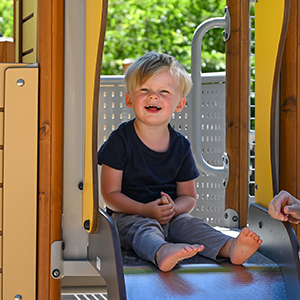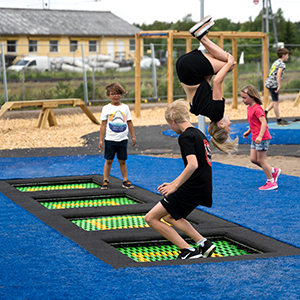Fill your basket with products by clicking "Add to my collection" from any product page. This can be found either within the product options panel or below the product image. Collections can be saved, and stored, within your HAGS Connect account or create and print your own custom brochure, download the files you need in one go, or to request a quote.
Physical Experience
Spinning
When children spin, different parts of the brain are stimulated at the same time. This develops and creates new neural pathways in the brain - pathways that improve learning, spatial awareness, rhythm and more. Spinning play develops motor skills and balance, while building muscle strength.
Choose different equipment that allows children to sit and spin, stand and spin and lie and spin. It can be either three products or the same product, such as SpinR², which allows children to sit, stand, lie down and spin.

Sliding
When children slide, they experience height, movement and the thrill of speed and risk. Slides stimulate children's vestibular system and sense of balance.
Have slides of different heights if possible, a wide slide is good for riding and supporting children with disabilities. You can also choose different types of slides, e.g. tube slide, curved, straight, spiral. to provide different experiences. Remember to use slides that do not create static electricity for people with a cochlear implant. A place to sit while the wheelchair is being retrieved is needed at the slide. Try to have the highest slide that is most exciting accessible, then it becomes a meeting place for children.
View Slides

Rocking
The rocking motion of a seesaw or springer stimulates and develops the balance system (vestibular system).
Choose products that allow movement both forwards-backwards and sideways. A great tip is to choose several products that inspire sitting-, standing- and lying-rocking, some seesaws allow for all variations.
Consider selecting a set of seesaws and rockers for both individual and group play. Larger sized seesaws are good to have around so that older children or adults can use them with the child.

Swinging
Rocking challenges, stimulates and develops children's vestibular systems. Swings come in many different models, and a varied playground can provide opportunities for children of all ages and abilities to swing.
View swings and swingseats

Climbing and Crawling
Climbing and crawling challenges and stimulates body awareness. We have divided climbing and crawling into three levels of difficulty to make it easier to choose a variety of experiences. Climbing activities should have at least two levels of challenge. Always remember to include level 1 as a choice.
Level 1: Equipment with a combination of the following characteristics:
- Close to the ground
- Low slope
- Handles or railings on both sides
- Possibility of leaning against the climbing gear for more support
- Clearly shows where to climb
Level 2: Equipment with a combination of the following characteristics:
- May be biased
- Has at least one means of support (leaning against a support, only one hand, etc.)
- Have several but clear paths to climb to the top, the first step should be easy to reach
Examples include a straight climbing frame with steady steps and good hand or foot support, a curved climbing frame with full body support.
Level 3: Equipment with a combination of the following characteristics:
- Reaches to a place high up
- Is vertical
- Has a complicated or multidirectional route to reach the top, minimal support, requires agility and strength to get up
This type of equipment is normally used by the older children. For example, a large stone with some support, a climbing net, vertical stone wall, etc.
View our Climbing section


Crawling
Choose at least two crawling activities that challenge children at different levels.
Level 1: Can be a short tunnel placed on the ground or uneven surface.
Level 2: A longer tunnel on the ground or elevated with accessible paths on each side.
Level 3: A tunnel with different heights and with the possibility to crawl between the different levels.

Balancing
An inclusive playground should offer a wide range of activities that stimulate children's need for challenge, while improving their balance and building physical strength.
Choose balance activities with different levels of difficulty. These can be both static and moving balance activities. Preferably also balance equipment where the child can sit and stand.

Jumping and Bouncing
Jumping and bouncing play is great for challenging, stimulating and developing balance and body awareness, while providing children with a fun activity that makes them feel like they are flying.
View Trampolines

Walk, run and roll
Create opportunities for children to play together while increasing their endurance, muscle building and strengthening their balance. Leave space between products where children can play games or follow tracks found in the surfacing. Use obstacle courses or mazes that are wide enough for someone in a wheelchair to pass through easily. Tracks that have uphill and downhill sections are fun and good exercise.
Experiences from a wheelchair or other assistive device
Enable children who use wheelchairs to play with friends and experience movements that stimulate balance without leaving the chair. Choose equipment that allows the child to stay in the wheelchair and play with other children, such as the inclusive roundabout or play panels.





